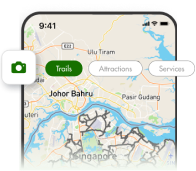- The public can enjoy rustic walks from Punggol North Avenue to Punggol Digital District’s Campus Boulevard, and explore over 1 kilometre of walking trails
- Themed trails feature a planting palette that reflects Punggol’s original coastal forest and kampung heritage
Singapore, 23 August 2025 – Today, the National Parks Board (NParks) opened the first 400-metre stretch of Punggol Heritage Trail, from Punggol North Avenue to Campus Boulevard, offering the public over one kilometre of meandering trails set amid a lush landscape. Distinctive features of Old Punggol Road have been retained, such as its original undulating terrain, coastal forest habitat, and existing greenery, inviting visitors to rediscover the area’s rich natural and cultural heritage.
Plans to transform Old Punggol Road into a 1.3-kilometre pedestrianised Punggol Heritage Trail were first announced in 2018 under the Punggol Digital District (PDD) masterplan. The Trail runs through PDD, seamlessly integrated with PDD’s Campus Boulevard, the Singapore Institute of Technology (SIT), and JTC’s business park. When completed, the Trail will connect Punggol Waterway Park to Punggol Point Park, providing convenient pedestrian access from residential estates, the SIT campus and offices in PDD to a variety of green spaces – including Punggol Waterway Park, Punggol Promenade Punggol Point Walk, and onwards to Coney Island Park – as well as community amenities such as Punggol Coast MRT station and the hawker centre.
This evening, residents in the area joined Advisers for Punggol GRC – Deputy Prime Minister and Minister for Trade and Industry Gan Kim Yong, Senior Minister of State for Education and Sustainability and the Environment Dr Janil Puthucheary, Senior Minister of State for National Development and Transport Sun Xueling, and Ms Yeo Wan Ling – to plant 60 native coastal trees along Punggol Heritage Trail to contribute to habitat enhancement efforts and commemorate SG60. The tree species planted include the Critically Endangered Common Putat (Barringtonia racemosa), as well as Endangered species such as the Dungun (Heritiera littoralis), Nipis Kulit (Memecylon edule), Red Teruntum (Lumnitzera littorea), and White Teruntum (Lumnitzera racemosa).
Senior Minister of State for National Development Sun Xueling said, “The Punggol Heritage Trail not only preserves the rustic charm and memories of Old Punggol Road but also serves as a green lung that runs through the Punggol Digital District (PDD), connecting offices, the SIT campus and homes. This highlights NParks’ ongoing efforts to strengthen the connectivity of our green spaces, bringing nature closer to where we live, work and study. We will continue to create more green spaces as we transform Singapore into a City in Nature.”
Bringing nature closer to the community
Much of the existing greenery, including trees that have been growing for at least half a century, has been conserved to preserve the area’s unique topography and rustic charm. These species include the Sea Almond (Terminalia catappa) and Common Pulai (Alstonia angustiloba). Additional native tree species such as the Pianggu (Horsfieldia irya) and Small-leafed Oil-fruit (Elaeocarpus mastersii), known for attracting birds, have been introduced to establish a multi-tiered native forest planting palette. These trees not only provide shade for pedestrians but also strengthen ecological connectivity to support biodiversity in the area. Other plant species added include the Bamboo Orchid (Arundina graminifolia) and Common Sendudok (Melastoma malabathricum).
In a nod to nostalgia, the former bus stop which once served residents in the area has been recreated along the Trail near Campus Boulevard, with a shelter design reminiscent of Singapore’s bus stops in the past. Visitors can learn more about the area’s rich heritage through interpretive signage placed at the bus stop as well as various points along the Punggol Heritage Trail. Supported by the National Heritage Board, these signage highlight key chapters of the area’s past, including Kampong Punggol, its private zoos, and the pig farming district that once existed in Punggol.
“The Punggol Heritage Trail is a natural extension of the SIT Punggol Campus, weaving Punggol’s history and character into our open, green campus design,” says Professor Chua Kee Chaing, President of Singapore Institute of Technology. “It is a space where the SIT community can recharge amid nature. The Trail links SIT with the rest of the Punggol Digital District, drawing students, staff, industry partners, and residents into a shared space for exploration and connection. Over time, we envision the natural surroundings, SIT’s green campus, and the Punggol community growing and maturing together into a unique, environmentally sustainable ecosystem.”
Upcoming plans for Punggol Heritage Trail
The Adventure Playground and Backwoods Trail, both situated along the newly opened 400-metre stretch of Punggol Heritage Trail, are slated for completion by end-2025. The Adventure Playground will feature design elements inspired by the childhood game ‘Pick Up Sticks’, alongside swing sets, creating a vibrant and immersive play environment. The 70-metre Backwoods Trail draws from the classic game ‘Snakes & Ladders’, featuring numbered sections along the footpath that replicate the game board. Winding through a forested area, the trail will guide visitors from the Barringtonia Track to the Adventure Playground.
The remaining 900-metre stretch of Punggol Heritage Trail is expected to be completed by end-2026. This upcoming section will feature conserved Api Api Ludat (Avicennia officinalis) mangrove trees, once a distinctive feature of the area’s coastal habitat, as well as a new connection to Punggol Jetty. The transformation of Old Punggol Road into Punggol Heritage Trail is part of ongoing efforts to expand Singapore’s network of green spaces and advance the vision of becoming a City in Nature, enabling more Singaporeans to enjoy the benefits of nature and greenery in their everyday lives.
- End -






